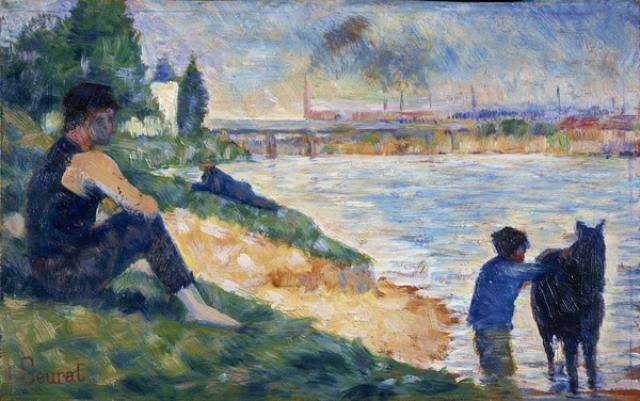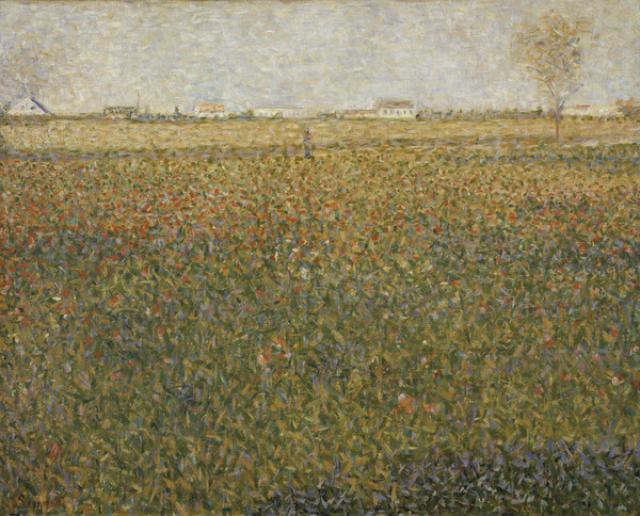Neo-Impressionism
An offshoot of Impressionism in which light effects were subject to a greater methodical analysis and paintings were composed with greater formality. Artists associated with this movement include Georges Seurat, Paul Signac and Camille Pissarro

The Origins of Neo-Impressionism
By the 1880s the tide had begun to turn against Impressionism, which many artists now felt was too fleeting and ephemeral. In 1886 French Impressionist Camille Pissarro suggested paintings in a newer style should be included in the last Impressionist exhibition, by his son Lucien, along with Georges Seurat and Paul Signac. The newer work was hung separately from paintings by the other Impressionists, comparing old and new versions of the same style, which was largely met with positivity. Critic Paul Adam wrote, ‘this exhibition initiates (us) into a new art’, and Felix Feneon first coined the term Neo-Impressionism (New Impressionism) to describe their style.
Seurat and Signac
Seurat is often celebrated as the most daring of the Neo-Impressionists, who came to prominence with his iconic Une Baignade, Asnieres, (The Bathers at Asnieres), 1884. With its urban leisure subject matter and glowing luminosity the painting makes a nod to several Impressionists, yet it is executed with a much greater sense of solidity and form. The young Parisian artist’s methods were far from fleeting; he made over fourteen sketches in oil as studies for the painting, along with a series of charcoal drawings that explored form and light, including Seated Nude, Study for Une Baignade, 1883 and A Study for Une Baignade, 1883. The final work was produced in his studio, not in the typical Impressionist manner of en plein air.
Signac was greatly impressed with Seurat’s paintings and in 1884 the two joined forces, developing mutual interests in colour theory and optics. Scientific texts they studied included Students’ Text-book of Colour: or, Modern Chromatics, with Applications to Art and Industry 1881, by American physicist Ogden Rood and more prominently, Principle of Harmony and Contrast of Colours and Their Application to the Arts, 1839, by Michel Eugene Chevreul.
Of particular interest was Chevreul’s ‘principles of simultaneous contrasts’; when the eye sees a colour, it automatically produces an after-image of its complimentary hue, and that complimentary colours placed next to each other will ‘blend’ in the eye. The Impressionists had already begun exploring the impact of unmixed areas of colour on canvas, which Seurat and Signac developed further, applying small areas of complimentary colours together in a dizzying haze of dots and dashes, demonstrated in Seurat’s La Luzerne, Saint-Denis, 1884-5 and his Sunday Afternoon on the Island of La Grande Jatte, 1886. The term Divisionism was applied to their theories and Pointillism to the technique of applying ‘dots’ of colour. Signac wrote, ‘The Neo-Impressionist does not dot, he divides.’
Neo-Impressionism and Symbolism
Seurat and Signac attracted a large number of followers in the following years, including Charles Angrand, Henri Edmond Cross, Albert Dubois-Pillet and Leo Gausson. There were also many overlaps between Symbolism and Neo-Impressionism, with a mutual interest in symbolic and expressive content. Both groups were attracted to progressive aesthetic theories on physiological responses to lines and colours, where horizontal lines produced a sense of calm, upward lines represented happiness and downward sloping lines invoked sadness.
Legacy
Seurat died young at the age of 31, but he, along with Signac, had a profound influence on future art movements. Through a series of exhibitions, Divisionist theories spread throughout Europe, most notably in Brussels and in Italy, where it became the basis of Italian Futurism. The revolutionary nature of the style is regarded as a precursor to Art Nouveau, De Stijl, Orphism and even Abstract Expressionism. It also led the way for the ‘heat haze’ and afterimage effects explored in Bridget Riley and Victor Vasarely’s Op Art.




